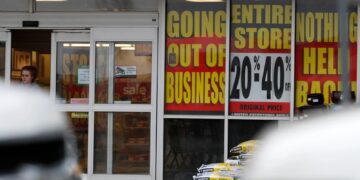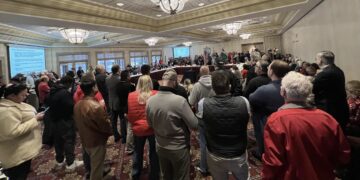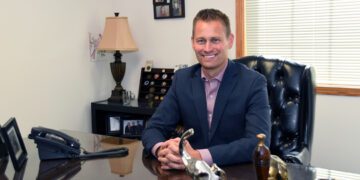NOTE: Illinois Review offers a platform for conservatives to share ideas, information and opinions. Opinion pieces are not to be considered Illinois Review's position or opinion on topics our gracious contributors submit to share with our readership. We encourage responses and comments in support or opposition.
By Nancy Thorner & Ed Ingold -
Tuesday, March 31, 2020, was promoted as the day when facts and figures would be presented to the public during the daily televised White House COVID Task Force news briefing to demonstrate why President Trump extended the stay-at-home timeline to the end of April. See here the Tuesday, March 31st news briefing.
At the March 31st news briefing, President Trump's task force unveiled grim projections of the pandemic’s toll on American lives. Trump was accordingly advised by his health experts that 100,000 to 200,000 people could die even if the restrictions remained in place. Thorner and Ingold, hoping to hear and see concrete and convincing information, were disappointed at what was shared by doctors Fauci and Birx and what was missing.
- Graphs of various models, with and without mitigation, had the same onset but with lower peaks and longer tails. One would expect slower onset and delayed peaks if mitigation were working.
- None of the models properly represents the total number of incidents. Since nothing in the present guidelines would prevent or cure the disease, each model should have the same area under the curve. Slowing of the epidemic would prolong its duration, hence its economic impact.
- Fauci dismisses the idea of testing for antibodies, which would show who is immune to the disease, and presumably free to move about without fear of infection or spreading the disease to others. Furthermore these antibodies could be harvested (from blood donors) and used to treat the most severe cases, and protect medical staff and first responders.
- Fauci and others frequently cite the need for more testing. While more data helps in the diagnosis and early treatment of the disease, we need more accurate data to fill in the blanks to gauge the strategic response and prognosis of our efforts.
- Birx conflated confidence intervals with tolerances ranging from 80,000 deaths to 240,000. They are not the same. They mean there is a 95% confidence that the true value will lie somewhere (anywhere) between those limits. The mean value is still the best estimate. Besides, confidence intervals for regressions (i.e., models) are notoriously wide because there are so many variables and possible interactions. The press naturally seized on the higher number and Trump waffled. That’s why it is risky to show confidence intervals to non-statisticians.
- When asked by CNN’s LaCosta whether he (Trump) regretted taking delayed action, Trump changed the subject. First of all, it was a “wife beating” question without a yes/no answer. The correct answer might be “As the charts indicate, we started before the numbers began to take off, and the peak value, based on the models, indicates we were correct in that assessment.”
- Birx states that the numbers were normalized to reflect the population, i.e., cases per 100,000. However, in the SIR model (susceptible – infected – recovered), we have little evidence of how many remain susceptible. That’s because we’re only testing those suspected to have the disease. Nor do we have good numbers on those recovered, or how long they may still infect others.
- While different populations cited by Birx have widely different infection counts, CDC data shows very little difference in rates of new infections. Without proper normalization, regions with more people show more infections (DUH), as reflected on her graphs.
- Nobody asked nor discussed the economic impact of delaying the restart of commerce, nor how it could be phased to balance the risks.
- No attempt was made to rank various remedies by cost/benefit ratios. These factors include many things short of a complete shut-down, such as hygiene, avoid close contact with strangers, do co-workers present the same risk as strangers at large. How many infections occur among store clerks, warehouse workers and delivery drivers? If someone is recovered and non-contagious, does it make sense to keep them sequestered?
The models presented Tuesday are very useful in simplifying complex ideas. Moreover, they can be used to both predict and test the efficacy of the efforts put forth to mitigate this epidemic. However, no model is better than its assumptions and the quality of the data used to test those assumptions. The key word is “quality” not “quantity.” At present we do not know any of the basic facts with enough clarity – S.I.R. – standing for Susceptible, Infected, Recovery.
Without good data on the number of asymptomatic infections, it is impossible to know the morbidity and mortality of the disease. These numbers will be exaggerated as a result. Without accurate data on serum antibodies, we cannot know who has recovered and how many remain susceptible, hence overestimating the rate the disease will spread. Without these numbers, we don’t know how many will need hospitalization or may die. We don’t even know if what we’re doing works, or what would happen if we stopped doing some things.
It is desirable to test as many people as possible for treatment, but not necessary for the purpose of modeling. There is a need for a definite representative sample, however, taken at random using the same tools used to conduct consumer and political surveys.
SIR COVID epidemiological model
There are three basic data points for the SIR COVID epidemiological model: Susceptible, Infected and Recovered. Of these only the first two have been measured, but incompletely with overlapping results. Without this data, the timelines, rate of infection, morbidity and mortality are based on assumptions and guesses.
Testing up to now has been restricted to those suspected of having the disease. Of these only 10% to 20% are found to be infected. We know little or nothing about the untested population. We suspect, but do not know how many people are asymptomatic but contagious, and next to nothing about how many have recovered and are now immune. Without hard data, confidence intervals on various estimates are questionable at best and wildly inaccurate at worst, typically overstated.
The beginning of knowledge is the recognition of what you don’t know.
The Neglected Factor: Economic Impact
Beyond the philosophical aspect, there are at least two sides to every practical situation, such as risk vs reward. It is hard enough to make these distinctions based on reason, much less on power politics. It is now the beginning of the month, when bills come due. The impact of shutting the economy down is has reached even the most jaded media reporter. As talented as they are, Drs. Birx and Fauci see things from one side – as caregivers who wish to preserve life at all costs, without knowing the extent of those costs.
The virus and the economy should be treated responsibility. If the remedy is too much the side effect will be much more disastrous. Emphasis during the Task Force daily is only on the coronavirus.
The shutdown may be doing irreparable harm to the American people and to small business which forms the engine of our economy? We cannot assume that business is simply on pause and will restart at the push of a button. A better analogy would be holding your breath, waiting for the flood water to recede. At some point it becomes irreversible. The coronavirus is adversely affecting small businesses, many of which may never open again.
Almost all countries in the West dealing with the coronavirus pandemic have by now arrived at the same lockdown strategy, with some local variations. Only one major exception stands out. Sweden, while facing an undisputed high-risk outbreak of the virus, has committed to going its own way in combating it. The Swedish government appears to be betting that its national culture is distinctive enough to pull off public health policies other countries can’t. Whether it will regret doing so remains to be seen.
New jobless claims topped 6.6 million the past week, well beyond last week’s stunning record 3.3 million claims and far past the 4-5 million economists projected. The US economy has now lost nearly 10 million jobs in the coronavirus pandemic, an economic disaster of epic proportions.
Stephen Moore , Trump's economic adviser and author of Trumponomics, had this to say in an interview on March 31, 2020:
“The US economy will get past coronavirus if President Trump sticks to April 30 deadline, but it the shutdown were to drag into May, June or July, the economic damage starts to cascade at a very fast pace.”
Meanwhile, in the perverse world of bureaucracy, H1B visa approvals, which import foreign workers for high tech jobs, have continued unabated. Up to 65,000 visas are allowed under law, with an additional 20,000 for applicants with masters' degrees or higher. Most of these jobs will go to people from countries in which the coronavirus is rampant, and otherwise subject to the travel ban. Most will go to work in the Left coast, the first epicenter of the epidemic, for companies which continue to thrive in the midst of our current destruction. Perhaps by coincidence, if you search for H1B facts on the internet, using the world’s largest search engine, you only get instructions on how to apply.
In summary, we need more balance, more reason, and more leadership, not just on the coronavirus itself but also on the economic impact of the coronavirus.







